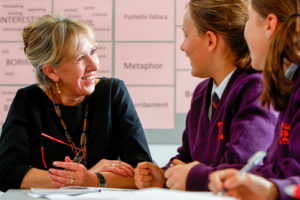A couple of weeks ago we considered using a freestanding Learning how to Learn course as a way of introducing Learning Power to students. This week we contrast that with a more integrated approach to putting Learning Power into secondary schools.
Let’s say the school has already:
- explored and developed its vision for learning.
- leaders and staff asked themselves what capabilities they wanted their learners to acquire that would serve them well in uncertain futures throughout their lives: to become lifelong learners.
- recognised that BLP learning habits make explicit and coachable the foundations of those qualities of mind that the school wants its students to acquire.
- recognised these learning habits as the essential ‘underfelt’ for the ‘carpet’ of the more familiar curriculum.
- come to the point of making decisions about how they might blend and embed knowledge, skills and habits of mind into types of learning opportunities over terms and years.
- rejected a simple solution of selecting just one subject area to become the pioneer for introducing the approach across the school.
- It’s often Humanities that is given this role because they appear to cover most learning behaviours with relative ease.
- Schools that have gone down this route have found it difficult or impossible to subsequently widen the scope to include other subjects. It’s been described as disastrous.
- decided it’s best to start with the full range of subjects…
- because this shows students that learning behaviours apply right across subject boundaries
- the ‘underfelt’ of the curriculum becomes alive and well throughout the day
It’s time to bite the bullet of mapping the curriculum – a key starting point
Schools can often do little more than guess which learning behaviours are already being well exercised and in which subjects. At this stage teachers are often unaware of the extent to which they are already developing specific learning habits. Many believe that, through their subject disciplines, the learning habits do just grow naturally whatever style of teaching they use. Furthermore students are usually completely in the dark about what learning habits they are developing—if any at all. This underfelt of the curriculum has always been a largely hit and miss affair…until now.
The guiding question that schools find helpful is:
- Do all subjects naturally exercise all the learning behaviours equally?
The answer seems to be that they don’t. Some subjects exercise and tend towards one subset of behaviours, while others tend towards another subset. Some seem to operate over a wide range of behaviours, while others seem to operate over a more limited set. That’s ok – different subjects exercise a different blend of behaviours simply by the nature of the subject. Thus across a broad, rich curriculum the whole dispositional underfelt is waiting to be brought out of the shadows.
Ask subject teams:
- Which learning behaviours gain regular exposure in your everyday classroom practice?
- OR alternatively: Which behaviours, if missing, would really limit students’ ability to succeed in the subject?
- AND the subsidiary question: Which behaviours rarely surface?
Experience suggests that such an exercise will show that almost all behaviours are exercised somewhere across the curriculum, but that few subjects regularly exercise all of them.
This discussion rapidly establishes a curriculum map of each subjects’ ‘go-to’ learning behaviours and the ones that they find hard to reach.
- Assign each subject one or two of their key learning behaviours that teachers will then be expected to talk about, nudge and stretch students in.

Jmyjmyz814 [CC BY-SA 4.0], via Wikimedia Commons
This way, no subject team starts by working out of their comfort zone, no subject is required to ‘force in’ a learning behaviour that doesn’t readily fit. What teachers are being asked to do is to bring those learning behaviours out of the shadows, notice them, make them explicit, celebrate them, design activities that bring them to life and nudge students to improve them.
What about the more generic learning behaviours?
- Emotional learning behaviours like Perseverance or Managing Distraction need to be a facet of every lesson.
- Social learning behaviours like Collaboration or Imitation should be honed frequently across a term.
- Strategic learning behaviours like Revising or Meta-Learning need to be embedded into all learning.
Although these dispositions need to be in play constantly, at this introductory stage many schools have paid attention to them them formally a term at a time. For example Sept-Dec the emotional dispositions are introduced, noticed, talked about and reinforced in lessons. Jan-April the social dispositions, May-July the strategic dispositions.
Integrate plans, look for the impact.
Planning:
- Ensure cross Faculty/subject planning is adequate and coordinates overlapping behaviours
- i.e. Making Links above is being explored in two different subject areas…are they using the same language?
- plan for the behaviours that are not the allocated behaviours. For example:
- Maths and Languages were both allocated Making Links, but Humanities still use it for cause and effect, similarity and difference type activities.
- How will the work being done in Maths/Languages be communicated to/shared with Humanities, and how will they build on it?
- ensure all teachers of the subject have the identified behaviours built into their medium-term plans.
Impact: Is a tricky one. The very way that secondary schools fragment the curriculum into ‘subjects’ limits rather than encourages transfer of the behaviours from one subject to another. Research also shows that learners find it hard to transfer skills learned in one context to similar situations in the same context, let alone apply them in seemingly different contexts. Which is why subject teachers need to be aware of the skills that are being grown and developed in other subjects and to build these behaviours into their own delivery as and when appropriate.
But wait a while: As time goes on, and all staff are trained to use the language of learning and to be comfortable with split-screen teaching, internal reviews of Learning Power will begin to show evidence that the range of learning habits being explicitly developed through individual subjects is growing as teachers’ confidence increases. Over three or four terms, the learning reviews are likely to show some surprising results: namely learning habits that subject teams initially regarded as difficult or even impossible to develop in a subject, are being developed and even regarded as perceived strengths. A broader range of learning habits will be evident in written schemes of learning, being made explicit in the classroom, and being systematically exercised and developed in most years by most subjects.
 The pros and cons of the integrated approach
The pros and cons of the integrated approach
The pros of the integrated approach are:
- Everyone is involved
- Mapping learning behaviours on to subjects helps teachers to understand Learning Power and often proves relatively straightforward
- Everyone works on behaviours that fit most readily in their own subject, where they are relatively comfortable
- There is no disconnect between learning behaviours and subjects.
The cons are:
- Everyone is involved!
- There is a risk that some teachers may think that since everyone else is doing it, it won’t matter if I don’t
- Planning and monitoring the impact are complex.
So – a freestanding course for students or integrated approach across the school? For many schools, the heart says Integrated, but the head says Freestanding, at least in the initial stages. Which way would you go? Did you go? What advice would you offer other schools?
What does all this learning friendly activity do for students? How are they changing and growing? What can they do that they couldn’t before? Is this way of teaching having an effect on their performance? Are they becoming better learners? Are there any habits that need explicit, whole-school attention because they are critical to success in a large number of curriculum areas, and which are showing up as a general weakness amongst students? We will tackle those questions next term.
By Steve Watson – Principal Consultant
 Steve Watson works as Principal Consultant for TLO. He is former Deputy Headteacher of Alderbrook School (Secondary) and co-owner of The Learning Nursery pre-school. Steve’s commitment to radically challenging teaching and learning in a comprehensive school context has made him focus schools on the development of their own language for learning based on Building Learning Power. His strategic yet hands-on approach wins respect and ensures that the vision is realised in practice.
Steve Watson works as Principal Consultant for TLO. He is former Deputy Headteacher of Alderbrook School (Secondary) and co-owner of The Learning Nursery pre-school. Steve’s commitment to radically challenging teaching and learning in a comprehensive school context has made him focus schools on the development of their own language for learning based on Building Learning Power. His strategic yet hands-on approach wins respect and ensures that the vision is realised in practice.


 The pros and cons of the integrated approach
The pros and cons of the integrated approach
No comments yet.